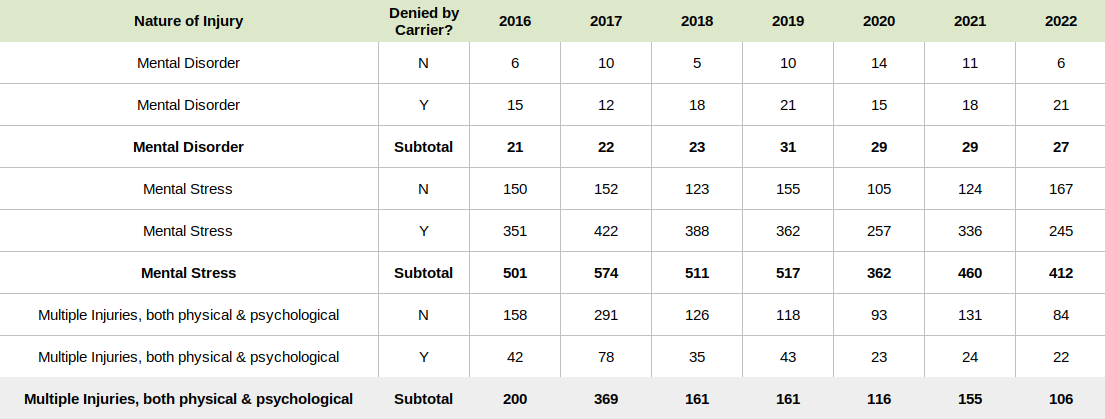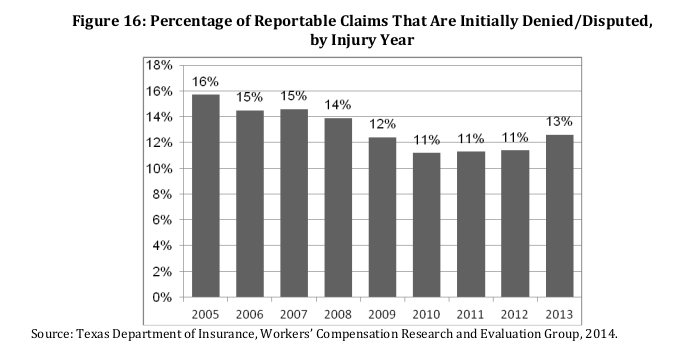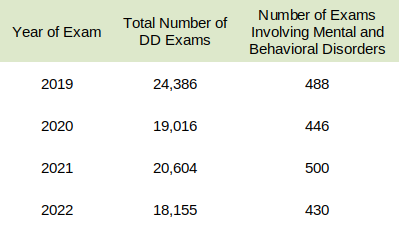What is the ‘state’ of mental health for injured workers in Texas?
Are Texans who sustain mental health injuries at work, directly or indirectly receiving the care they need?
What is the ‘state’ of mental health for workers compensation injuries in Texas? How many employees sustain a mental health injury on the job? How does mental health treatment for workers compensation compare to treatment of physical only injuries? Does a disparity exist in evaluation tools doctors use to rate injuries?
As you may suspect, many more questions than answers remain when looking into the state of mental health treatment in the Texas workers compensation system.
How many Texans sustain mental health injuries as a direct or indirect result of on the job injuries?
That is not known. The Texas Department of Insurance does not publish that data and it is not known what, if any record-keeping is maintained for mental health injury rates.
What is currently known is the number of mental health claims under Texas workers compensation that were denied by insurance carriers. Additionally the number of designated doctor exams that are preformed for mental health injuries is known.
What is not known, is how many were requested and denied. This data was obtained from an open records request by the author.
Number of mental health related claims 2016-2022

How many claims are typically denied?
If we look at the data expressed in terms of a percentage, the percent of claims denied for mental disorder or stress averages around 70% denied. For multiple injuries, physical and psychological the denial rate year over year averages 20%. Why the discrepancy? How does this denial rate compare to physical only injuries in the Texas worker's compensation system?
The last publicly available data shows that the percentage of claims (physical only) disputed typically averages around 12.75% a year.
This is far lower than the 70% plus denial rate for mental health only injuries.
...70% plus denial rate for mental health only injuries

Another data point that gives an indication as to how many injured employees are receiving care for mental health injuries is to look at the number of designated doctor exams preformed. These are exams that confirm extent of injury and medical necessity.

This data for the last four years shows that only a mere 2% of designated doctor examinations were for mental health claims.
How does Texas workers compensation evaluate mental health job injuries?
Currently Texas is utilizing the 4th edition of the American Medical Association, Guides to the Evaluation of Impairment (AMA Guide). Published in 1993.
This is the text workers compensation doctors use to evaluate an injury and determine how serious the injury is. This rating determines treatment and monetary benefits for the injured employee. As you may imagine, for an injured employee having the best and latest medical tools to properly evaluate your injury that will determine your benefits is of upmost importance.
However that is not the case when it comes to evaluation of mental health injures in Texas.
The current edition (4th) has a mere two pages on “A Method of Evaluating Psychiatric Impairment”.
As you can imagine mental health diagnostics and treatment have changed considerably in the past 30 years since the current guide used was published.
For example the 4th edition makes no mention of the Diagnostic and Statistical Manual of Mental Disorders (DSM-5-TR 2013) , the standard for mental health professionals when making a diagnosis.
Additionally the impairment guide currently used does not include the “Brief Psychiatric Rating Scale” (BPRS), a tool clinicians use to measure symptoms such as anxiety and depression. The BPRS and DSM-5 are referenced in the latest version(s) of the American Medical Association, Guide to Evaluation of Impairment.
By not adopting a more current and scientifically updated version of this guide, Texans who sustain mental health injuries are starting disadvantaged in an already burdensome system with little hope for proper treatment.
How does AMA Guide use in Texas compare to other states in the US?
Only six states use the 4th edition of the AMA guide, with two states using an older edition and 16 states use a state specific guide for evaluation.
The remaining 24 states use a newer 5th or 6th edition of the AMA Guide (LexisNexis survey, 2019).
What can be done to improve mental health evaluation and treatment in Texas workers compensation?
- The Texas Department of Insurance should evaluate and review the latest version of the AMA Guide for adoption. If necessary portions of the guide could be adopted, for example mental health only.
- Improve data collection, record-keeping and reporting when it comes to mental health injuries sustained by Texas worker's. This will allow a better understanding of what the state of mental health treatment is under workers compensation.
- Include and publish this data in annual agency reporting to the public and the legislature.
These initial steps will tremendously improve evaluation of mental health injures and help improve treatment for a major disparity that currently exists in Texas workers compensation.




